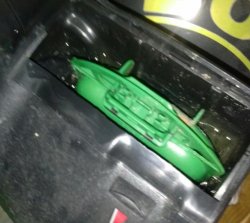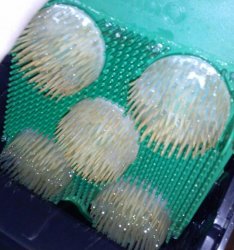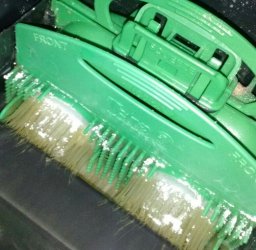I'm not a new aquarium keeper but I'm a newly educating aquarium keeper. I've kept my 10 gal. tank for 3 years now ignorantly, and never knew about cycling, and never went through any process, so I all of a sudden have a whole lot of questions. This is a betta tank, 10 gal, heated, in the process of being planted.
I was getting ready to get a handful of shrimp and 2 snails to add in with my betta, because I want a community tank but don't have a community fish, I like having a few things at when I look in the tank and after asking a forum I was a part of about suitable tankmates, I was introduced to the idea of the nitrogen cycle. For the first time ever I got a test kit, freshwater API master kit, instead of strips I got and barely used. I knew in the past I had always had ammonia problems with my goldfish, I just assumed that was in part to their mass production of waste. But I tested yesterday and the ammonia turned bright green: BAD!! and no nitrites or nitrates. So I added some ammonia detoxifier but its not a permanent solution... I need to get my tank cycling! I'm doing a water change tonight (we have arsenic in our well water so we have a special filter or drinking water but it only filters 2 gal. about every 2 hours, and only has a 2 gal. capacity, so filling water for changes can be a pain when we use the water for cooking that night) I can't take my betta out since all I have are 1 gal tanks which he would probably die in, so i'm trying to cycle with him in the tank (I guess i'm using the fish in method since I have no choice, I had thought it was a well established tank since it had been running for so long. The only time I ever cleaned the bio filter was in between goldfish and betta, since the goldfish died of a horrible fungus that NOTHING was treating, so I didn't want it anywhere near new fish! I have a tetra Whisper filter for 20 gals (since with my goldfish that filter power was needed), so the bio-filter is a little insert with spines that the bacteria stick to, is this an adequate bio-filter? I know the ammonia was extra elevated because due to personal matters I missed changing the filter for 2 months (bad bad I know, but my life literally did have a falling apart moment and one of the most important things was forgotten) I'm writing it in my planner large when carbon filter changes are required so that never happens again, I was relying on the red timer strips that come with the cartridges but they're just as easy to forget about as the filter. I read somewhere the bio-filter is necessary in all aquariums (weird because the tanks original filter had no bio insert...) but that chemical (carbon) filtration wasn't required, I currently have my activated carbon out but is it important? I can put a new one in, I just don't know if they're actually important after reading that.
I put in so bioenzyme, I've read people have successes and failures with it but I had it because a petco employee told me to get it when I had my goldfish water testing high ammonia, I only now know why he said to get it. But due to its age (probably around 2 years) it probably wont have effect, but I figured it wouldn't hurt to at least try to introduce it.
I just need some advice on what exactly to do next. I'll test it again either tonight or tomorrow and see if anything is changing, but I am beginning to doubt my tank ever had nitrates or nitrites, and that's a little alarming that I've been caring this poor for so long...
Also my PH was around 6, so I'm not sure if the water change will help that (can I test both the aquarium water and water straight from my filtered faucet to compare? or will that not matter?)
Basically I know cycling requires a lot of time and not too much additions on my part with a fish producing the ammonia, so do I just sit and wait for it to cycle? If theres no Nitrites (or Nitrates) this long having the tank established are there more problems I need to focus on? Should I clean out the bio-filter and start over at this point? I mean I've had betta in this tank for over a year at this point. Or should I start looking closer at the care I've been giving and my filter and water change lapses, and while working to adjust those to proper maintenance watch and see if anything changes?
If there's any information I haven't provided that is needed just let me know. Because i'm new to this stuff and not being a horrible ignorant aquarium keeper.
~Sarah
I was getting ready to get a handful of shrimp and 2 snails to add in with my betta, because I want a community tank but don't have a community fish, I like having a few things at when I look in the tank and after asking a forum I was a part of about suitable tankmates, I was introduced to the idea of the nitrogen cycle. For the first time ever I got a test kit, freshwater API master kit, instead of strips I got and barely used. I knew in the past I had always had ammonia problems with my goldfish, I just assumed that was in part to their mass production of waste. But I tested yesterday and the ammonia turned bright green: BAD!! and no nitrites or nitrates. So I added some ammonia detoxifier but its not a permanent solution... I need to get my tank cycling! I'm doing a water change tonight (we have arsenic in our well water so we have a special filter or drinking water but it only filters 2 gal. about every 2 hours, and only has a 2 gal. capacity, so filling water for changes can be a pain when we use the water for cooking that night) I can't take my betta out since all I have are 1 gal tanks which he would probably die in, so i'm trying to cycle with him in the tank (I guess i'm using the fish in method since I have no choice, I had thought it was a well established tank since it had been running for so long. The only time I ever cleaned the bio filter was in between goldfish and betta, since the goldfish died of a horrible fungus that NOTHING was treating, so I didn't want it anywhere near new fish! I have a tetra Whisper filter for 20 gals (since with my goldfish that filter power was needed), so the bio-filter is a little insert with spines that the bacteria stick to, is this an adequate bio-filter? I know the ammonia was extra elevated because due to personal matters I missed changing the filter for 2 months (bad bad I know, but my life literally did have a falling apart moment and one of the most important things was forgotten) I'm writing it in my planner large when carbon filter changes are required so that never happens again, I was relying on the red timer strips that come with the cartridges but they're just as easy to forget about as the filter. I read somewhere the bio-filter is necessary in all aquariums (weird because the tanks original filter had no bio insert...) but that chemical (carbon) filtration wasn't required, I currently have my activated carbon out but is it important? I can put a new one in, I just don't know if they're actually important after reading that.
I put in so bioenzyme, I've read people have successes and failures with it but I had it because a petco employee told me to get it when I had my goldfish water testing high ammonia, I only now know why he said to get it. But due to its age (probably around 2 years) it probably wont have effect, but I figured it wouldn't hurt to at least try to introduce it.
I just need some advice on what exactly to do next. I'll test it again either tonight or tomorrow and see if anything is changing, but I am beginning to doubt my tank ever had nitrates or nitrites, and that's a little alarming that I've been caring this poor for so long...
Also my PH was around 6, so I'm not sure if the water change will help that (can I test both the aquarium water and water straight from my filtered faucet to compare? or will that not matter?)
Basically I know cycling requires a lot of time and not too much additions on my part with a fish producing the ammonia, so do I just sit and wait for it to cycle? If theres no Nitrites (or Nitrates) this long having the tank established are there more problems I need to focus on? Should I clean out the bio-filter and start over at this point? I mean I've had betta in this tank for over a year at this point. Or should I start looking closer at the care I've been giving and my filter and water change lapses, and while working to adjust those to proper maintenance watch and see if anything changes?
If there's any information I haven't provided that is needed just let me know. Because i'm new to this stuff and not being a horrible ignorant aquarium keeper.
~Sarah

 /www.hamzasreef.com/Contents/Calculators/FreeAmmonia.php
/www.hamzasreef.com/Contents/Calculators/FreeAmmonia.php

